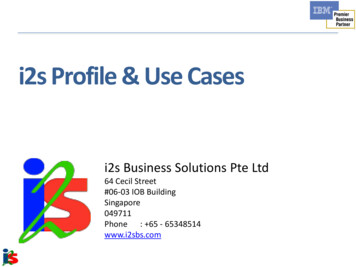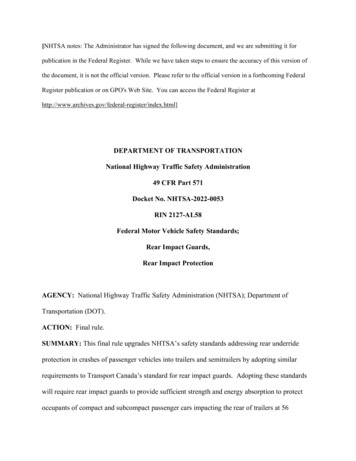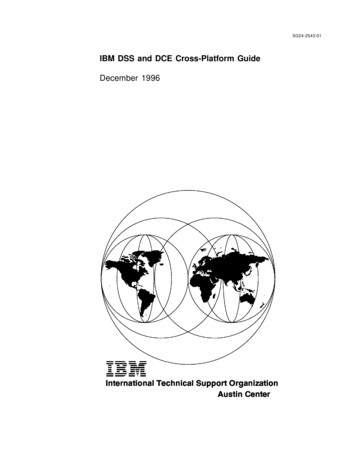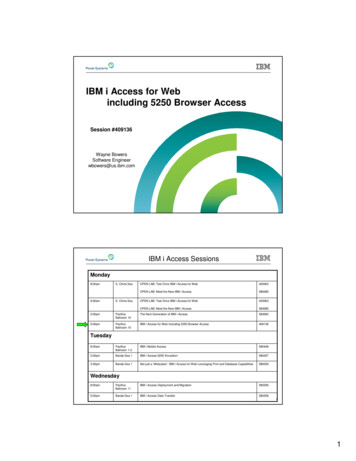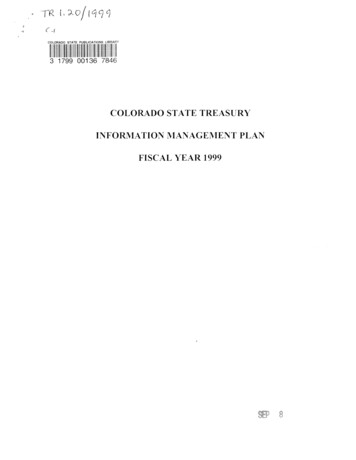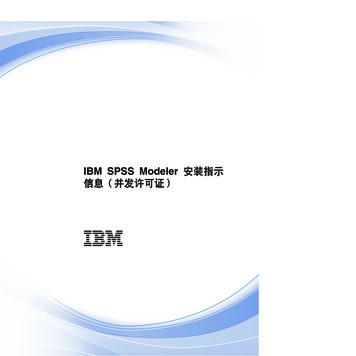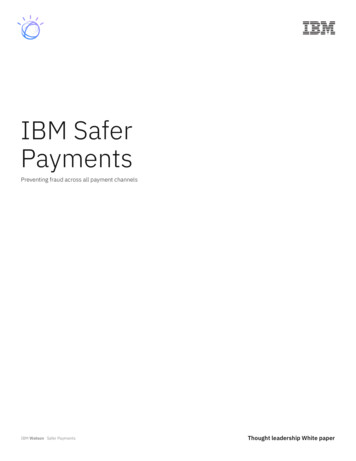
Transcription
IBM SaferPaymentsPreventing fraud across all payment channelsIBM Watson Safer PaymentsThought leadership White paper1
IBM Safer PaymentsIBM Safer Payments is the industry’s first true cognitive fraudprevention solution to payment processing and protects some of thelargest and most complex payment portfolios in the world. Usersreport that IBM Safer Payments significantly reduces fraud losseswhile keeping false alarms to a minimum. This new approach servicesall payment channels.IBM believes that using one modelling technique to fix theshortcomings of another is a logically flawed approach. To avoid thisflawed approach, next generation solutions use cognitive computing tocreate one clean and efficient model.How IBM Safer Payments is differentNext generation IBM Safer Payments’ cognitive approach also usesautomatic learning from past data. But rather than generating a blackbox model, it generates easily readable rules and fraud preventionscenarios, IBM Safer Payments enables a generation of new or revisedmodels with considerably less data and renders faster model updatecycles, helping to result in higher fraud detection rates at drasticallylower false positive rates.First generation payment fraud prevention solutions use codedexpert experience. This included velocity counters and expert rulesto identify high risk. The value of this approach was in its simplicity.However, the ever-increasing number and complexity of fraudpatterns have rendered this approach inefficient.In addition, local specialists can enhance such rules and scenarios asthey are easy to read and to understand. They can also combine themwith their own human experience, and perform frequent updates ofthe models. In fact, the automated learning is so fast and efficient thatsome users elect to adapt their models up to multiple times per week.Figure 1: Next generation cognitive model generator uses artificial intelligenceFigure 2: Manual creation of decision rules as part of rule sets.to create decision rules.Second generation solutions generated fraud detection models frompast data. Neural networks and advanced statistics used for thistypically required collecting large amounts of data over a long periodof time. This data is then sent to the vendor that creates a model offsite. By the time the model is put into production, the fraud patterns itdetects can be a few years old.Their experience is confirmed as providing them with a competitiveadvantage. This approach curbs emerging fraud patterns at theearliest opportunity while keeping false positives low.Democratization of model generationSecond generation solutions date back from a time when fraudpatterns only changed slowly, so this was not too significant aproblem. In today’s world, however, new patterns of fraud attack arefrequently introduced and the speed of change is only accelerating.As a result, neural network vendors have thus added first-generationrules engines to their products, so that the customers can createworkarounds to their aging models. This is because neural networksare black boxes; they only generated a score that cannot be explainedby looking at the model. In addition, the neural network model cannotbe explicitly modified. Experience shows that some users of neuralnetwork-based solutions have moved away from dependence on themodel and only use the rules function to mitigate cost and erraticperformance.IBM Watson Safer PaymentsSecond generation fraud prevention often implied that users haveto ship their data off site to the vendor, who then generated a modeland shipped it back to the user. Unfortunately, the black-box natureof the model prevents the user’s fraud analysts from gaining anyunderstanding how the model works. And in case it does not performwell, they have no way of explicitly modifying it.This renders users at the mercy of their vendors. The cognitivecomputing approach of IBM Safer Payments’ next generation productfrees users from this dependency. Because users are enabled by theartificial intelligence to create their own models, they become selfcontained and independent.2
The proof: all users of Safer Payments are adapting their existingfraud prevention models without needing any assistance from IBM.Many have even created full day-one models for new lines of businesscompletely independent of help from IBM.Customer successIBM Safer Payments today protects some of the largest and mostdemanding applications in the world, delivering outstanding results.COMDATA, a major US corporate card issuer has used IBM SaferPayments technology since 2007. In COMDATA’s MasterCard portfolio,IBM Safer Payments reduced the fraud level from the market average12 basis points for corporate credit cards to just two basis points1.And even more importantly, the false positive rate was reduced tojust 1:3, which is only a fraction of the 1:20 to 1:40 reported by otherissuers in the US.IBM Safer Payments is also the leading fraud prevention solutionfor the chip and contactless card era. The first major economy thatcompletely converted to chip cards was France in 1992. While thisinitiative initially reduced fraud significantly on credit and debit cards,fraud eventually returned. In fact, in 2013, the European CentralBank reported the highest fraud losses in the Eurozone for France.Since 2014, IBM Safer Payments helps protect French-issued cardsand French merchants from fraud from its central installation at theNational payment switch2. Sized for 10 billion transaction messagesannually, a peak performance of 4,000 transaction messages persecond, and a maximum latency of 3.5 milliseconds, this is one of theworld’s largest payment portfolios.IBM Safer Payments also helps protect the payment systems of thefuture. QIWI (NASDAQ: QIWI) is the dominant mobile payment systemin Eastern Europe. It operates 200,000 cash deposit ATMs, serves 75million active account holders and processes seven billion financialtransaction messages annually. Enrolling with QIWI is as easy asinserting a banknote in one of the many ATMs, entering a mobilephone number as the account number and choosing a password. Thefunds can then be transferred to any other QIWI user, be used at pointof sale (POS) or to pay invoices. Accounts are typically accessed byaccount holders through their mobile phones. A system so easy toenroll and so convenient to use, naturally becomes a honey- pot forcriminals. Thus, QIWI employs IBM Safer Payments to keep its easyonboarding and payment processes protected from financial crime.this is not sufficient. Born out of necessity, neural network vendors inthe 1990s created the concept of the consortium model, where theypooled data from multiple users to create models.While this has worked somewhat well in the past, and in homogenousmarkets, consortium models fall short in today’s dynamicenvironments. In small payment markets, fraud patterns are ratherregional and thus blending data from multiple user results in lowdetection rates and many false positives. In large payment markets,fraud patterns tend to become more and more individual by user, soconsortium models become less and less effective.In direct comparison, the cognitive approach yields stable models withmuch less data than neural networks require. This means that evensmall or medium sized users can afford a custom model. Optimized forthe fraud patterns this user experiences, a custom model generateshigher fraud hit rates and lower false positives.As an added benefit, the fact that model updates—such as adaptationsof an existing model to emerging fraud patterns— require very littlenew data, the cognitive approach also allows to update models withindays and even hours of a new fraud pattern emerging.Providing value to the payment ecosystem segmentsFraud prevention may be a common goal for all participants of thepayment ecosystem, but what this exactly means is not the same fordifferent types of payment companies. IBM Safer Payments has beendesigned to provide each participant with a solution tailored to theirspecific needs.Figure 3: Constant monitoring of fraud prevention performance highlightsnon-performing rules.These three examples are representative of many successful IBMSafer Payments implementations.Farewell, consortium modelNeural networks and advanced statistical methods require massiveamounts of training data to create a stable model that does not overfit.Frequently the amount of data that individual users can provide forIBM Watson Safer PaymentsCredit or debit card issuers must keep a tight control on their fraudlevels. Though their earnings are small compared to the totaltransaction amounts, they underwrite the full risk. At the same time,they strive to offer the best customer experience, which is primarilyachieved by ensuring legitimate transactions are not being declined.IBM Safer Payments is the right solution here because it combines avery high fraud detection rate with ultra-low false positive rates.3
For card-present purchases, POS acquirers usually do not bearthe fraud losses. However, they must protect themselves againstthe risk of merchants defaulting and ensure compliance withpayment scheme rules. IBM Safer Payments is the right solutionhere because it combines tight merchant control with the abilityto intercept transactions in real time. It also offers specific andconfigurable reporting on merchant compliance, as well as acomplete investigation work ow for merchants violating schemerules or exposing high-risk behavior.ATM acquirers operating networks of ATMs have access to a massivenumber of non-financial messages exchanged on ATM network level,known as machine events. IBM Safer Payments is the right solutionhere because it allows for merging such non-financial transactionsto historical profiles section of ATM channel specific fraud, such asgas attacks, skimmer installation and cash trapping.E-commerce acquirers facilitate payments for Internet merchants.Because they process card-not-present transactions, theirmerchants bear the full liability of fraud. IBM Safer Payments is theright solution here because it assesses the individual risk of eachmerchant by enabling each merchant to accept transactions basedon their individual appetite for risk. High-margin merchants typicallyaccept a higher fraud risk with transactions as long as they addto their bottom line. At the same time IBM Safer Payments helpsensure payment scheme compliance.Online and mobile banking are attacked by phishing schemes,malware and cybercrime. The challenge is to provide not onlyfraud security, but also the best possible customer experience.IBM Safer Payments is the right solution here because it profilesthe transactions, identifies counterparties and devices, identifiesmalware—all in the background—with no impact to the customer,nor additional security steps needed. Only when IBM SaferPayments identifies a high risk transaction will that transactionbecome the subject of further scrutiny and step-up authentication.This approach also provides compliance with various regulations,such as the revised Payment Services Directive (PSD2) issued by theEuropean Union.SWIFT and high value payments pose a unique fraud detectionchallenge. Fraudulent transactions in this channel are rare andbarely distinguishable from genuine transactions. However, missingjust one fraud is extremely expensive. Protecting these paymentsrequires understanding each customer’s normal behavior across adiverse set of parameters—some about the transaction, some aboutthe parties, and some about the context. IBM Safer Payments isuniquely capable because the solution maintains a deep history ofeach customer in memory so normal patterns are readily availableto the detection process. As payments are evaluated, the paymentinstructions are enhanced with information about the context ofeach payment to provide a total view. By evaluating paymentsacross this diverse set of behaviors, even the shortest of variancesfrom your customer’s normal behavior is identified in order to stopthe first fraud.IBM Watson Safer PaymentsACH and wire transfers have not traditionally been a prime targetfor criminals. However, this is changing as these transactions movetoward real-time execution. IBM Safer Payments is the right solutionhere since it allows profiling payment behavior in multiple historicaldimensions in real time. Fraud attacks, in which large amountsof money are structured and smurfed through the system usingmultiple small amount transactions, are securely detected as IBMSafer Payments’ profiling engine restores the true flow of money andsecurely blocks transactions that are part of such a fraud scheme.Fintech companies all over the world are working on alternativemobile payment systems that do not rely on card schemeinfrastructure. Some are already entrenched in their localeconomies, while others attempt to disrupt traditional paymentpractices. IBM Safer Payments is the right solution here because itprovides unprecedented flexibility. New data streams can be addedin f light, matched and merged with other data streams, to form abehavioral history that allows for the secure detection of risky andfraudulent activity.A significant number of IBM Safer Payments’ users are processorsor switches that work for multiple banks or other paymentproviders. IBM Safer Payments is the right solution here because itprovides hierarchical multi-tenancy, including inheritance. Thisenables processors or switches to have generalized models, such asa region model or an industry model, and allow for each of theirtenants to have any kind of bespoke addition to such a model. IBMSafer Payments is PCI PA-DSS certified and designed to be hostedby a payment processor as a service to its processing clients.Protecting the Internet channelE-commerce acquirers, payment gateways and online bankingface the same problem: they need to secure the identity of theircounterparties. This is more complicated with Internet-generatedtransactions when the counterparty of the transactions— buyer oraccount holder—is not physically present and there is no materialtoken such as a payment card. IBM Safer Payments is the rightsolution here because it provides a full set of functions to establishidentity and to detect fraud with transactions originated in theInternet.An embedded device fingerprinting and identification mechanismfeeds into a device reputation database that profiles all deviceseach counterparty ever used. This allows IBM Safer Payments toassess whether the currently used device is in fact owned by thecounterparty. At the same time, the devices themselves are profiled.If for instance a device never used before within a short amount oftime is used with a number of otherwise unrelated accounts, this isan indicator of high risk.IBM Safer Payments also extracts device intelligence. A customer4
may pretend to be in the UK and come in with a UK IP address, butwhen IBM Safer Payments identifies that the browser language isMandarin, the time zone is Shenzhen and that this is the first time theaccount has been accessed with these settings, it considers this anindicator of high risk.Also IP/ISP usage is profiled. If the counterparty uses an ISP frequentlyused before, this is a low risk indicator compared to using an ISP neverused before. There are also know high risk ISPs and known low risk ISP.But IP/ISP are not just profiled for counterparties, they are also profiledwithin their own usage history. Massive attacks by organized crimeare typically conducted from a single ISP and sometimes even a smallset of IP addresses. A significant number of similar transactions frommultiple accounts originating from a single ISP that was never usedwith any of these accounts before is an indicator of high risk.Similarly, target accounts in mobile and online banking are profiled.A target account that has previously been used by an accountholdermultiple times over a certain time period most likely is not linked to afraudulent attack. IBM Safer Payments even uses social intelligence:target accounts used frequently over a time period by other accountholders are not likely linked to a fraudulent attack; even if the currentaccount holder uses such a target account for the first time.identification of a full past behavioral profile of a cardholder, accountholder, originator, beneficiary, intermediate, merchant, terminal, ATM,POS and so forth. This profiling is fully performed in real time, which isat the time a current transaction message is processed. The result ofthe profiling thus becomes available to the actual decision model whilethe transaction is still in process.The methods of profiling are multifold. Counters can generate a profilesuch as “how many times was this card used at the current same ATMin the past 72 hours where the amount withdrawn is the one mostfrequently withdrawn by the customer in the past three months”.Patterns allow to find specific sequences of transactions and eventsthat occurred in the past. Calendar profiles compute averages andfrequencies of any type of transactions in any calendar period in thepast. Collusion profiles rapidly identify common points of purchase inthe past of multiple cards that were compromised. Events recordspecific occurrences in the past and measure how much time haspassed since.It is important to notice that all of these profiling methods are fullyconfigurable in flight and that all data elements of all data streams canbe used in their definition.Figure 4: Powerful real-time profiling engine analyzes historical behavior of allIBM Safer Payments can also be loaded with each https request of amobile or online session. The specifics, sequence and timing of thehttps request can be matched to known malware signatures. Thisallows for the identification of active and acting malware in a session.entities.Omni-channelAs previously described, IBM Safer Payments provides the channelspecific feature set needed to prevent fraud in any payment channeland any line of business. It is important to notice that most IBM SaferPayments’ installations support multiple lines of business. This not onlyreduces the total cost of ownership, but it also allows profiling entitiesthroughout the payment channels, and thereby to detect inter-channelfraud.For example, if a bank’s online banking accounts are compromised andthe fraudsters do not immediately transfer money outside the bank.Instead, they use mule accounts within the same bank, and then useATM withdrawals, POS transactions and e-commerce transactionsfrom the mule accounts to take out the proceeds. Such a fraud patterncan only be detected securely when the flow of money is followedthroughout the bank’s silos.Profiling engineThe heart of IBM Safer Payments’ fraud detection capability is itspowerful profiling engine. It features a number of different ways toprofile past behavior in any historical dimension. This enables theIBM Watson Safer PaymentsDecision engineAll data fields of all data streams, as well as all profiling computeddata can be used in IBM Safer Payment’s decision engine. The decisionengine allows for the definition of rules and scenarios, structuredin rule sets and scenario assemblies, and modelled in a hierarchy.Rules and scenarios both represent decisions with respect to the riskassessment of the current transaction message, as well as policies onhow to act on this assessment and invoke any kind of external action.One type of such action is the risk scoring or decision with real-timetransaction messages. The authorization system or transactionplatform that sends data of a current transaction to IBM SaferPayments as a message receives back information on whether to5
authorize this transaction or to decline it. Alternatively or in addition,this yes/no type decision is accompanied by a risk score or theestimated probability that the current transaction turns out fraudulentlater on.resources needed by the real-time engine. Since in an averageproduction situation, most of the computational resources are not usedby the real-time process, free resources are generously available toperform simulations and analyses.Decision rules and scenarios can also trigger actions in other backoffice systems of a payment processor. For instance, a payout for aspecific merchant can be blocked until an operator reviewed the case inthe investigation workflow and cleared the account block. Decisionrules and scenarios can also generate notifications about transactionsto parties as emails, fax or text messages.Because the virtual simulation on the production environment puts adata layer between the challenger and the data, any experimentationwith the challengers never alters the real production data. Because thefraction of the data changed in any virtual simulation is rather small,most of the data needed can come from the production data store. Thisis a very efficient utilization of the production server’s computationaland memory resources and allows for any kind of simulation andanalysis to be started with real production data to start instantly. Thisprocess is near instant and shortcuts the lengthy traditional processof data extraction, moving from production to test environment, andloading/processing it there.Another type of action is an investigation case alarm. Such alarmscan be created for real-time transaction messages as well asfor transactions loaded in batch files. Alarms are used to createinvestigation cases for various case queues and may contain individualpriority scores. They can be used both in IBM Safer Payments’integrated case investigation workflow and with other caseinvestigation tools.Figure 6: Case investigation workflow selection function allocatesalarms to investigators.Figure 5: Flexible decision model analysis tools enable generation of efficient models.End-to-end solutionSimulation and analysis environmentIBM Safer Payments contains a complete virtual simulation testbed.This allows for each local fraud analyst using IBM Safer Paymentsto create any number of challenger models to the current champion.With a challenger, new and modified fraud counter measures such asprofiles and rules and scenarios are created, and their effectivenesscan instantly be simulated for a defined period of real productiondata. If the challenger outperforms the champion, it can be promotedinto production to become the new champion. This entire process isgoverned by a revision control system that provides full audit trails andallows to exactly identify how any past decision at any time was made.The important element here is that all these challengers are simulatedwithin the same physical environment that performs the actual realtime decisions using virtual sandboxes. A sophisticated priority schemeensures that no such simulation or analysis would ever consumeIBM Watson Safer PaymentsIBM Safer Payments provides a full set of functionality that supports allfunctions of a multi-channel payment fraud prevention solution.A real-time decision engine executes profiling of thousands oftransaction messages per second within milliseconds latency. It allowsfor the profiling into any historical dimension. This includes cardholderand account holder behavior, merchant/ terminal/ATM behavior,but also merchant categories, regions, IP/ISP, devices and so forth.Because these profiles can be built across silos, inter-channel fraudpatterns can be prevented.Since certain profiles require the assessment of individual pasttransaction records while the current transaction message isperformed, IBM created a purpose-built database for Safer Payments.This database, optimized purely for the purpose of payment fraudprevention, can be of orders of magnitude faster than any genericdatabase technology. In processing payment data and profilingbehavior, users have benchmarked it to orders of magnitudes fasterthan general purposes database systems. This is partially from its6
Figure 7: Detailed reporting on model performance.generated for different case queues, and each case queues’ reportingpages can be freely configured and customized. Cases can also beassociated with a score by the decision engine for prioritization withincase queues.IBM Safer Payments’ profiling engine works with a streamlined historyof past transaction records that are locally stored. To create thishistory, typically transaction messages from various data streams aremerged: settlements are merged with authorization requests, fraudalerts are merged with transaction records, and session requests aremerged with payments. IBM Safer Payments comprises a f lexible andpowerful merging functionality for this.use of in-memory and not-only-SQL technology, however, most ofits performance gain comes from building it for the sole purpose ofprocessing payments data.The massive performance of the IBM Safer Payments’ database is alsothe key behind its ultra-fast statistical analysis and interactive reportingcapabilities. Analyses that have taken hours with general-purposetechnology only take minutes with IBM Safer Payments’ purpose builddatabase.Because this ultra-fast database technology also propels the analyticalcapabilities within any simulated challenger, the performanceof different decision models is quickly compared, and efficientdevelopment of fraud countermeasures is provided. Because IBM SaferPayments’ simulation sandboxes are virtual, any user can create anynumber of models and analyze/ test/develop them in parallel.IBM Safer Payments’ simulations are created as virtual data layers, sothey allow for each of the decision models to access the real data andmanipulate it, however, manipulated data only exists in the virtual datalayer where it can be analyzed. Real data is never changed.Any frontend access to data and functionalities is controlled by aconfigurable user role model. This allows for a refined control ofaccess, while at the same time it enables an efficient management ofhundreds of users. Interfaces to companywide user authenticationsystems simplify user logins.In addition to a full query module and configurable reportingcapabilities, IBM Safer Payments also features a customizabledashboard. It allows for the display of configurable alarms and thecharting of key performance indicators. It also can reach out toindividuals by email, text or WhatApp if certain thresholds are reached.It can also feed into centralized monitoring systems.To document both technical and business events, IBM Safer Paymentsfeatures a configurable event logging engine. Several hundredindividual events can be configured to be logged for in system logs andaudit trails. These logs can be locally stored and viewed within IBMSafer Payments, but also be delivered to centralized logging facilitieswithin a data center.Figure 8: Investigation case reports are fully configurable formultiple case queues.Because of this, simulating fraud countermeasures with IBM SaferPayments provides instant results: the virtual sandboxes are builtaccording to any selection criteria the user defines— such as period,region or industry—and created dynamically within minutes or seconds.No need to export production data from a production environment,moving it to the test/ simulation environment, and importing it there.All operations—real-time and others—are executed fully redundant.IBM Safer Payments uses a service-oriented architecture (SOA) andis designed to operate in a cluster of multiple, identical IBM SaferPayments instances. Within such a cluster, the instances replicate alltransaction data and all configuration change automatically. IBM SaferPayments is configured and sized so that as long as there is still oneinstance up and running, it can take the full real-time load and alluser activity. This approach to redundancy allows creation of any levelof availability by just adding instances. Most IBM Safer Paymentsinstallations operate at an availability level of 99.999 percent and areusing three or four instances.In addition to real-time reactions, IBM Safer Payments canalso generate investigation cases. A completely integrated caseinvestigation workflow is part of IBM Safer Payments. Cases can beIBM Watson Safer PaymentsLowest total cost of ownershipIBM Safer Payments is created for maximum scalability. While it canprotect the largest payment portfolios of the world, it remains thesimplest software product to install, maintain and operate.A case in point: all binary code of IBM Safer Payments is contained7
Figure 9: Configurable dashboard displaying key performanceCompletely configurableindicators and operational alarms.IBM Safer Payments is designed to be configurable in any aspect.When IBM comes on-site to assist with an implementation, IBMconsultants sit down with the clients’ local specialists and as a firststep, the various data feeds are identified for all the payment channelsto protect. The data feed configurations are defined by simply typingthem in using IBM Safer Payments’ web interface, which is as easyas filling out a spreadsheet. Next, the physical interfaces are definedto the data feeds on the web user interface. For real-time interfaces,online messages that IBM Safer Payments responds to are defined inmessage formats, transportation layers and security properties. Forbatch interfaces, file formats, delivery types and import schedules aredefined.in one single executable file, 15MB in size. It not only contains allbusiness logic of all functions of IBM Safer Payments, it also containsthe entire purpose build database as an embedded component. Thereis thus no separate database to be procured, installed, administeredand patched. Because the embedded database has no parameter thatmust be set from the outside, there can be no misconfiguration andimplementation is faster.The single executable file also contains an embedded applicationserver. Again, nothing needs to be procured, installed, administered,and patched. Even the entire replication logic is embedded in the singleexecutable file. If one IB
IBM Watson Safer Payments 2 IBM Safer Payments IBM Safer Payments is the industry's first true cognitive fraud prevention solution to payment processing and protects some of the largest and most complex payment portfolios in the world. Users report that IBM Safer Payments significantly reduces fraud losses while keeping false alarms to a minimum.



